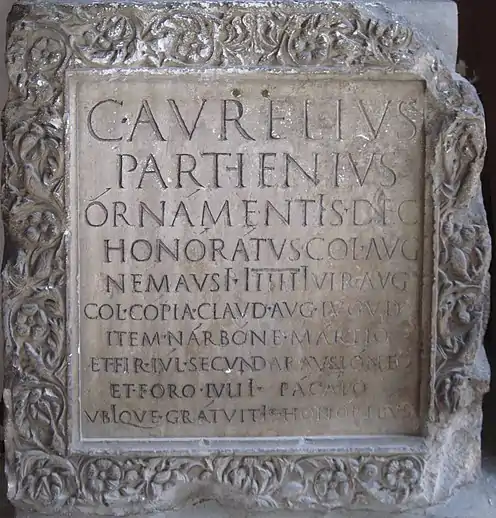Long i (Latin: i longum or [littera] i longa), written ⟨ꟾ⟩, is a variant of the letter i found in ancient and early medieval forms of the Latin script.
History
In inscriptions dating to the early Roman Empire, it is used frequently but inconsistently to transcribe the long vowel /iː/. In Gordon's 1957 study of inscriptions, it represented this vowel approximately 4% of the time in the 1st century CE, then 22.6% in the 2nd century, 11% in the 3rd, and not at all from the 4th century onward,[1] reflecting a loss of phonemic vowel length by this time (one of the phonological changes from Classical Latin to Proto-Romance). In this role it is equivalent to the (also inconsistently-used) apex, which can appear on any long vowel: ⟨á é í ó v́⟩ /aː eː iː oː uː/. An example would be ⟨fIliI⟩, which is generally spelled fīliī today, using macrons rather than apices to indicate long vowels. On rare occasions, an apex could combine with long i to form ⟨Í⟩, e.g. ⟨dÍs·mánibus⟩.
The long i could also be used to indicate the semivowel [j], e.g. ⟨IVSTVS⟩ or ⟨CVIIVS⟩,[2] the latter also ⟨CVIVS⟩, pronounced [ˈjʊstʊs, ˈkʊjːʊs]. It was also used to write a close allophone [i] of the short i phoneme, used before another vowel, as in ⟨CLAVDIO⟩, representing [ˈklau̯.di.oː].[3]
Later on in the late Empire and afterwards, in some forms of New Roman cursive, as well as pre-Carolingian scripts of the Early Middle Ages such as Visigothic or Merovingian, it came to stand for the vowel ⟨i⟩ in word-initial position. For example, ⟨iNponunt in umeroſ⟩, which would be inpōnunt in umerōs in modern spelling.
In Unicode
The character exists in Unicode as U+A7FE latin epigraphic letter i longa, ⟨ꟾ⟩, having been suggested in a 2006 proposal.[4]
Examples
 Roman inscription, ca. AD 100, showing long i's contrasting with apices on other vowels, for example órnámentIs in line 3 (besides other words), representing the vowel /iː/.
Roman inscription, ca. AD 100, showing long i's contrasting with apices on other vowels, for example órnámentIs in line 3 (besides other words), representing the vowel /iː/.![Roman inscription, ca. AD 45, showing a use of the long i letter for the close [i] sound of Latin short ĭ before a vowel: claudIo.](../I/lossy-page1-89px-Ara_a_Tib%C3%A9rio_Cl%C3%A1udio_MNArqueologia.tif.jpg.webp) Roman inscription, ca. AD 45, showing a use of the long i letter for the close [i] sound of Latin short ĭ before a vowel: claudIo.
Roman inscription, ca. AD 45, showing a use of the long i letter for the close [i] sound of Latin short ĭ before a vowel: claudIo. Roman inscription, ca. AD 69, showing a rare use of long i with an apex in line 1, dÍs mánibus.
Roman inscription, ca. AD 69, showing a rare use of long i with an apex in line 1, dÍs mánibus. Roman letter in Old Roman cursive, ca. AD 50 from Claudius' reign, showing handwritten long i's: rebus iis · iúdicibus (line 2), imponátur qui · intrá (line 3).
Roman letter in Old Roman cursive, ca. AD 50 from Claudius' reign, showing handwritten long i's: rebus iis · iúdicibus (line 2), imponátur qui · intrá (line 3). Manuscript samples in New Roman cursive from the 6th century. Top: quantum s(upra)s(cripto) emptori interfuerit. Bottom: tenentes igitur palestini.
Manuscript samples in New Roman cursive from the 6th century. Top: quantum s(upra)s(cripto) emptori interfuerit. Bottom: tenentes igitur palestini. Manuscript samples in Merovingian script from ca. AD 700. Top: et inponunt in umeros hominum. Bottom: in synagogis · et salutationis in foro.
Manuscript samples in Merovingian script from ca. AD 700. Top: et inponunt in umeros hominum. Bottom: in synagogis · et salutationis in foro.![Codex Vigilanus, from the late 10th century in Visigothic script, folio 22v, preface of Vigila the scribe (pictured). The first line contains three examples of long i: in exordio igitur hui[u]s.](../I/Codex_Vigilanus%252C_Vigila_scriba%252C_folio_22v.jpg.webp) Codex Vigilanus, from the late 10th century in Visigothic script, folio 22v, preface of Vigila the scribe (pictured). The first line contains three examples of long i: in exordio igitur hui[u]s.
Codex Vigilanus, from the late 10th century in Visigothic script, folio 22v, preface of Vigila the scribe (pictured). The first line contains three examples of long i: in exordio igitur hui[u]s.
References
- ↑ Gordon, A. E. (1957). Contributions to the Palaeography of Latin inscriptions. p. 216.
- ↑ Allen, Sydney (1978). Vox Latina: The Pronunciation of Classical Latin (2nd ed.). Gateshead, England: Athenaeum Press. pp. 37–39. ISBN 0-521-22049-1.
- ↑ Allen, Vox Latina, pp. 51-52, giving the examples dIes, prIvsqvam, pIvs
- ↑ Davud J. Perry (2006-08-01). "Proposal to Add Additional Ancient Roman Characters to UCS" (PDF). Retrieved 2018-09-30.